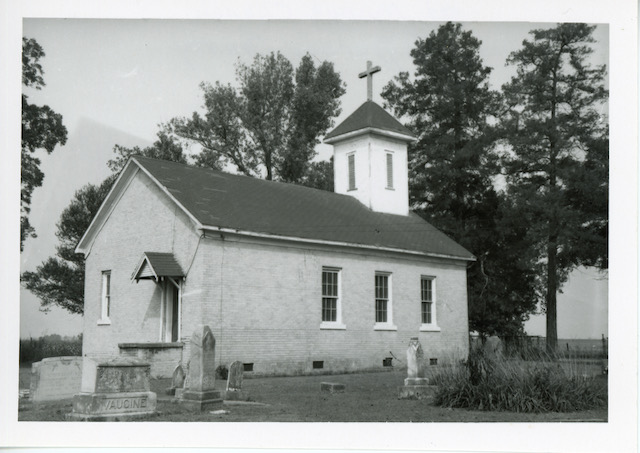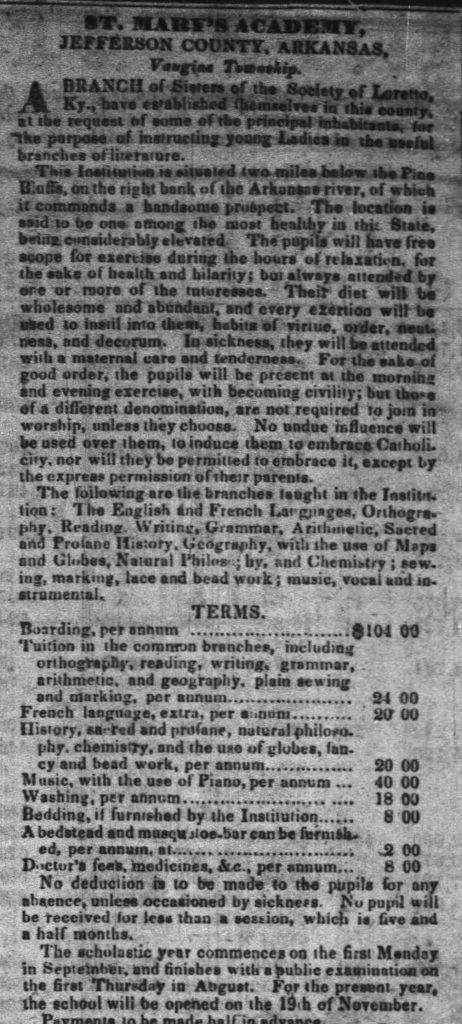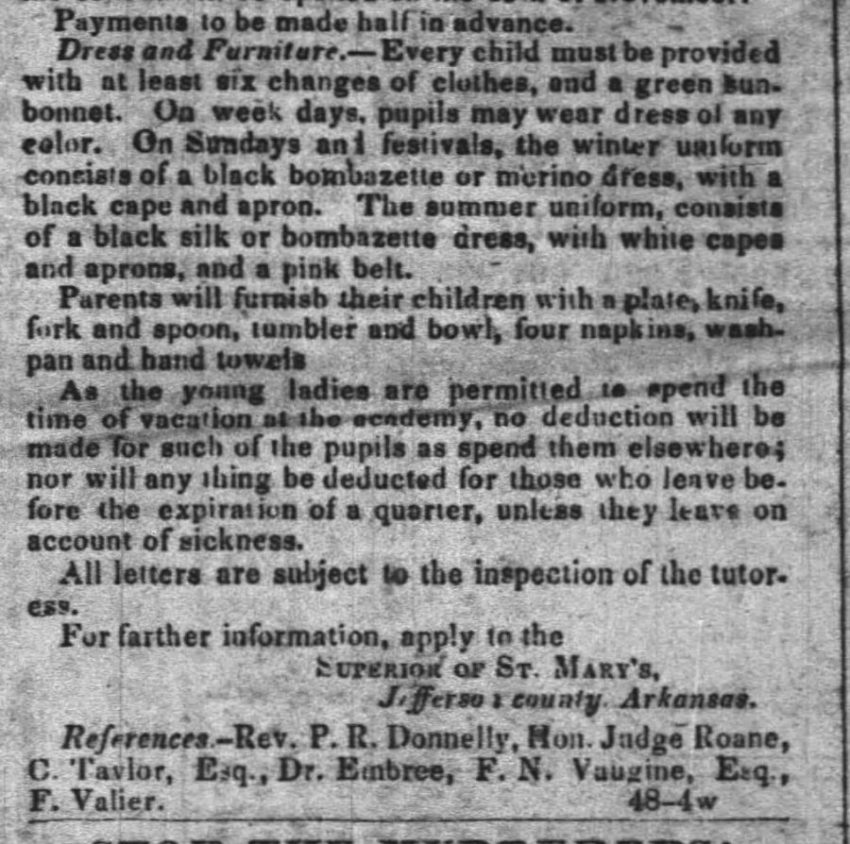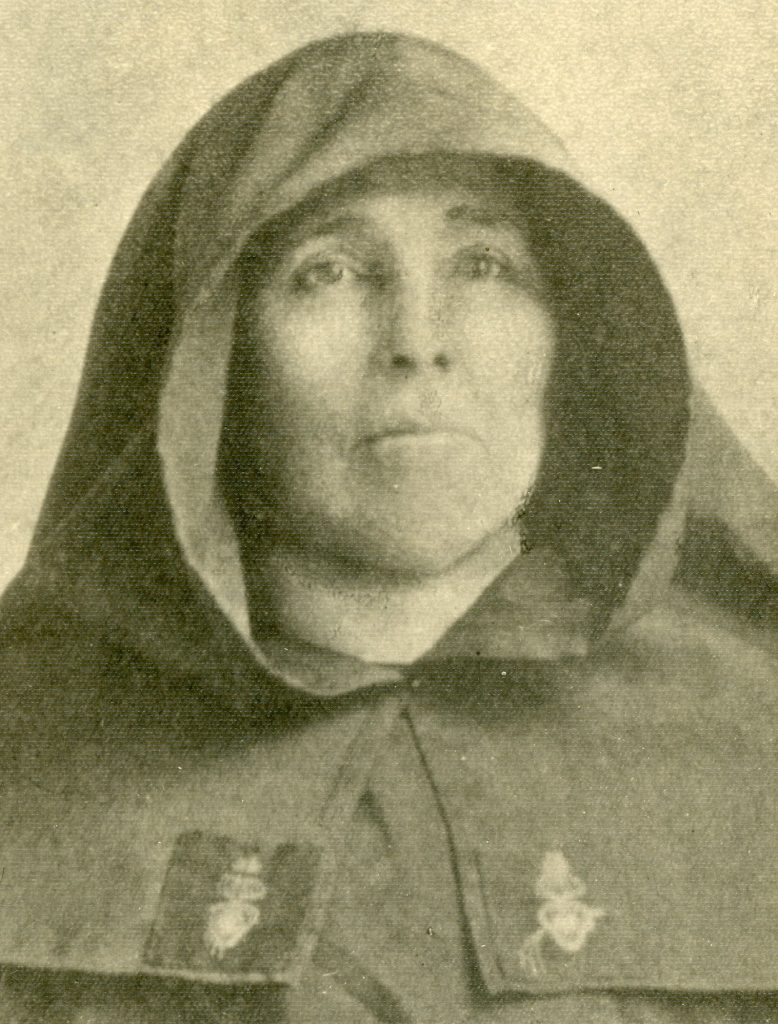Loretto’s Years in Arkansas, 1838-1845
Posted on June 7, 2022, by Susanna Pyatt
Despite the fact that Loretto established three different schools in Arkansas, they all vie for some of the shortest-lived Loretto houses. None lasted more than four years. They were all founded at a time when Loretto was expanding across the European-American frontier of the United States, moving along with the institutional Catholic Church from Kentucky into Missouri and the Midwest. Whereas many of Loretto’s schools in Kentucky and Missouri thrived and were open for decades, if not over a century, all three schools in Arkansas closed after only a few years.
Part of the problem in Arkansas may have been the demographic situation. Loretto first came to Arkansas in 1838. Arkansas had only recently become a state, and the influx of settlers was largely comprised of Anglo-American Protestants and the persons they enslaved. Arkansas was barren of priests for the first decades of the 19th century, and the missionary priests who arrived in the 1830s rarely lasted more than a year. These European-born priests struggled to find the money and congregational interest to construct formal churches in the pockets of Catholic population around Pine Bluff, Post Arkansas, and Little Rock.

Image from the Loretto Heritage Center collections.
The first Loretto school in Arkansas was founded near Pine Bluff in fall 1838. Sister Agnes Hart and two other Sisters of Loretto1 who came out with her were given a log house and land by Col. Creed Taylor for their foundation. The establishment was later expanded with a school building made of lumber milled by Taylor. The Sisters quickly found over two dozen students, both boarding and day scholars. One 1952 newspaper article reported that the school accounts showed that “The students came from the best families, its rolls resemble a roster of the pioneers and makers of the river country, aristocratic and well-to-do. The convent’s governing board consisted of the top names in the new state of Arkansas.”2
The Sisters taught a variety of subjects at the school. The “common branches” included reading, writing, grammar, orthography, arithmetic, geography, and plain sewing. Tuition for this curriculum was $24 per year. For an additional $20 per year, the curriculum expanded to include history, natural philosophy, chemistry, fancy needlework, and beadwork. There were added fees for instruction in French and music. The cost for each boarding student was set at $104 per year, with additional fees for washing, bedding, bedstead and mosquito bar, and medical care. Guardians were expected to provide their students with dishes, a wash pan, napkins and towels, and at least six changes of clothes.


Image courtesy of Newspapers.com.
While the students came from “the best families,” the frontier situation still limited the availability of cash for payment. Many parents and guardians paid their accounts through provisions such as shoes, beef, pork, bacon, potatoes, corn, beans, salt, sugar, household articles, livestock, and more. They also paid accounts through labor—not always their own. While some parents and even students themselves worked to pay part of tuition and board, it was more common for partial payment to be through the “hiring” of enslaved persons.3
The time and value of these individuals’ labor varied. Some worked for the Sisters for only a few days or a week, while others were contracted for several months. The labor of enslaved persons was typically valued less than that of the guardians, sometimes as little as $1.00 per week. There is no way to tell the age of the enslaved persons, but several are referred to in the account book as “boy” or “girl” rather than “man” or “servant.”
This practice of paying for school through enslaved labor may have been indispensable to the Sisters. St. Mary’s Academy in Pine Bluff was founded by only three Sisters, who would have not only been teaching as many as 30 students of all ages, but also running a household and taking care of their student boarders. Over the course of the seven years that Loretto was in Arkansas, there may have been as few as eight Sisters total who served in the state, and that small group was at times split between two different schools.4 The Sisters may have been reliant on this enslaved labor for accomplishing the domestic duties of the academy households.

Image from the Loretto Heritage Center collections.
The Sisters of Loretto opened St. Joseph’s School in Little Rock in 1841, and they moved from Pine Bluff to St. Ambrose’s School in Post Arkansas in 1842. The moves only transferred financial problems that the Sisters faced. They had assumed a large debt in Pine Bluff, which was only partially offset by donations and other arrangements with their major supporters. After opening the school in Little Rock, the debt rose to over $3000. Snippets from archival documents suggest that the purportedly scandalous character of a housekeeper in Pine Bluff and the prospect of starvation in Post Arkansas may have contributed to the closure of the Arkansas houses. Whatever the exact reasons, it appears that these schools were deemed unsustainable by the Sisters of Loretto, and the Lorettines withdrew from Arkansas in 1845 to use their resources and energy elsewhere.
Notes
1 Sr. Lilliana Owens, SL, reports that the three Sisters who founded St. Mary’s Academy were Agnes Hart, Eulalia Kelly, and Alodia Vessels (Loretto on the Old Frontier, 1823-1864, p. 49). However, many secondary publications about the school say there were five Sisters who founded the academy.
2 Mary Roane Tomlinson, “Old St. Mary’s Founded 170 Years Ago” (Arkansas Democrat Magazine, 11/16/1952).
3 Though Sisters of Loretto directly enslaved people of color at other locations, they may not have done so in Arkansas. The national census does not list any enslaved or free black people in the St. Mary’s Academy household in 1840. The household at that time consisted of two white young adult men, 8 white girls under the age of 20, and 6 adult white women ages 20-50. The men may be clergy or hired labor, though there are also records in the school account book of several male students/boarders.
4 The Sisters known to have taught in Arkansas are Agnes Hart, Elizabeth Hayden, Eulalia Kelly, Teresa Mattingly, Louisa Phillips, blood sisters Aloysia Rice and Mary Rice, and Alodia Vessels. Eulalia, Alodia, and two others opened the school at Little Rock in 1841. Alodia also founded St. Ambrose with Teresa Mattingly and two other Sisters. Agnes Hart died at St. Mary’s Academy in August 1839. When her body was exhumed several decades later because the church building and cemetery were being moved, her remains were found to be petrified. There has been some conversation among the parish members in Arkansas of trying to have Mother Agnes canonized; in addition to the preservation of her body, she was credited with a miraculous cancer healing in 2007.
